Plant pieces cut from a parent plant and rooted to form new plants are called “cuttings.” Use of cuttings is a simple, inexpensive way to multiply houseplants and garden plants.
Many plants can be propagated by cuttings. Each new plant will have the characteristics and genetic makeup of its parent plant. Table 1 lists some plants that can be easily propagated at home and indicates the type of cutting or other suitable propagation technique to use for each.
Types of cuttings
Cuttings may be taken from stems, leaves or roots. Herbaceous stem cuttings, sometimes called slips, are commonly used. Popular plants such as African violet and begonia are propagated from leaf cuttings. A few plants may be propagated by cutting their long stems into segments, and others can be propagated by simple division.
Herbaceous stem cuttings
The type of stem cutting suitable for propagating most houseplants is the herbaceous cutting, which is made from tender growth of terminal shoots. Herbaceous cuttings are commonly used to propagate geranium, chrysanthemum or coleus (Figure 1). Cuttings taken from a rubber plant, dracaena or croton usually contain more woody tissue and are often called softwood cuttings. Techniques for taking and rooting these cuttings are the same, however.
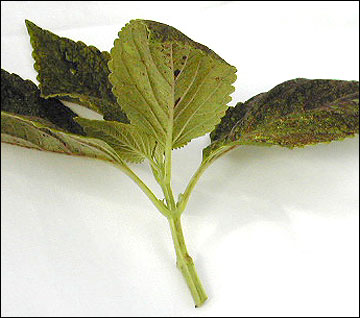 Figure 1
Figure 1
Five-inch coleus stem tip cutting that contains a terminal growing point.
Leaf cuttings
Leaf cuttings include only a leaf blade or the blade and a portion of the petiole (Figures 2 and 3). Leaf cuttings of plants such as African violet should not be rooted with long petioles. Trim the petiole to no more than 1/2 inch long.
If a small portion of the main plant stem containing a bud is included with the petiole, the cutting is known as a leaf-bud cutting. Use of leaf-bud cuttings is limited. Hydrangea and rubber plants, however, are sometimes started with leaf-bud cuttings.
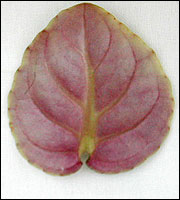
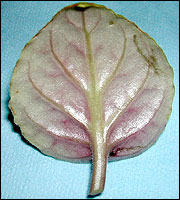 Figures 2 and 3
Figures 2 and 3
Violet leaf cutting without the petiole and cutting with a 1/2-inch petiole.
Plants from stem sections
A few houseplants may be propagated by cutting 1- to 2-inch sections from the stem (Figure 4). These segments, without leaves, are placed in the rooting medium in a horizontal position and covered slightly.
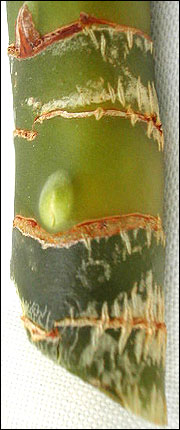 Figure 4
Figure 4
Stem section cutting with a prominent axillary bud.
How to take cuttings
Take cuttings from vigorous, healthy shoots. Most cuttings should be 4 to 6 inches long. Cut just below a node (where a leaf is attached) with a sharp, clean knife.
Remove leaves from the lower half of the cutting. Use a rooting hormone on all except easy-to-root plants such as coleus. Rooting compounds are available from many garden supply stores, mail-order seed and nursery companies, and mass merchandisers. Carefully read and follow label directions when using rooting compounds. Keep cuttings clean. Don’t place cuttings in dirty containers or on dirty tables.
Containers
A 6- to 8-inch plastic pot filled with quality potting soil can be used to root several cuttings. Place the pot in a large plastic bag, and seal the bag to maintain high levels of humidity (Figure 5). Do not place the bag in direct sunlight.
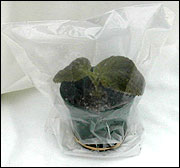 Figure 5
Figure 5
Large zip-type plastic bag secured at base of pot with a rubber band.
Rooting materials
Clean, coarse, construction-grade sand is suitable for rooting many cuttings; however, it needs to be heat-sanitized prior to use. It is also excellent mixed with an equal volume of peat moss.
Vermiculite is a lightweight material used for rooting. It holds water well and promotes root growth.
Perlite is another excellent propagation material. It is lightweight and provides good aeration for rooting. Perlite makes one of the best rooting materials when mixed with an equal volume of peat moss.
Don’t use field soil as a rooting medium. It packs too tightly when wet and is prone to develop diseases.
Compressed peat pellets are available for seeding and can also be used for rooting cuttings. The pellets expand rapidly when soaked in water. Place them in plastic bags after soaking and draining; insert a single cutting in each pellet and close the bag at the top. No additional watering is necessary until the cutting is rooted and the bag opened.
Cleanliness
Pots, medium and equipment used for rooting cuttings must be clean and sterile. Pots should be washed thoroughly using a household cleaner and disinfectant. Tools should also be washed in such a solution or dipped in alcohol. Any rooting medium that is not known to be sterile can be moistened and heated thoroughly in an oven at 150 to 200 degrees F for 20 to 30 minutes. Peat moss, vermiculite and perlite don’t need sterilization when new.
Inserting the cutting
Promptly place the prepared cutting in the rooting material. Stick the base of the cutting 1 or 2 inches deep, depending on the length of the cutting. Firm the medium around the base and settle the medium by watering.
Care of cuttings
Never allow the propagation medium to dry out during the rooting process.
Because the cuttings have no root system, high humidity must be maintained at all times. Clear plastic is inexpensive and easy to use for covering the cuttings. A plastic bag slipped over a pot is simple and airtight. Support the plastic with wire loops or stakes if necessary to keep it from resting on the leaves.
Never place a plastic-covered container in direct sunlight. Heat will build up under the plastic and burn the foliage.
Care of rooted cuttings
The time needed for cuttings to form roots differs greatly among plants. Check the cuttings occasionally by carefully removing a few from the medium. When a cutting has roots at least 1 inch long, transplant it into a separate container.
The move from high humidity and moist rooting conditions to lower humidity and drier soil is the most critical step in successfully growing new plants from cuttings. Closely monitor the young plants the first few weeks after the move.
A good potting medium designed for houseplants is suitable for potting newly rooted cuttings and can be found at local garden centers or mass merchandisers.
After a cutting has become established in the medium, apply a soluble houseplant fertilizer according to directions. Then fertilize at monthly intervals. When the cutting is growing vigorously, normally in spring and summer, fertilizer may be applied every two weeks. During the winter, fertilize once a month.
Division
Division is the easiest method of multiplying plants that naturally produce offsets or basal shoots. These new shoots usually have a few roots and can be separated and planted individually (Figure 6).
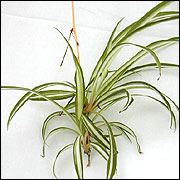 Figure 6
Figure 6
Spider plant offset from the parent plant.
Layering
Layering is a method of rooting a new plant while the stem is still attached to the parent plant. This easy propagation method can be done in the home without special equipment or structures. The four layering techniques — simple, tip, air and compound — are discussed in detail in MU Extension publication G6970, Home Propagation of Garden and Landscape Plants.
Air layering
- Remove all leaves several inches on each side of the point where the layer is to be made.
- From the center of the layering area, make a slanting cut upward an inch or more in length and about halfway through the branch. A preferred method of wounding is removing a strip of bark 1/2 to 1 inch wide around the branch (see Figure 7).
- Apply a rooting hormone to the wounded surface or cut.
- If a cut has been made, don’t let it heal. Instead, insert a small piece of sterile wood such as a toothpick in the cut to keep the wound open.
- Take a handful of unmilled sphagnum moss that has been soaked in water and squeeze out excess water. Pack the moist sphagnum around the branch to cover the wound.
- Cover the ball of moist moss with clear plastic wrap; an 8- by 10-inch sheet is generally large enough. Wrap the plastic around the moss so that it overlaps and will not allow the moss to dry out. Clear plastic permits you to see when roots have developed.
- Secure the plastic at each end with electrical tape, string, plant ties or other convenient fasteners. It will usually take a month or more for roots to appear.
Compound layering
Compound layering is suitable for long vines that may be alternately covered and exposed. Wounds should be made on the lower portion of each curve. For more information, see MU Extension publication G6970, Home Propagation of Garden and Landscape Plants.
After rooting, the vine can be cut into segments, each containing its own roots.
Care after rooting
Root systems of newly rooted layers are small in relation to the canopy. After the new plants are severed from the parent plant and potted, the humidity must be kept high. Enclose the new plants in a loose, clear plastic bag for the first week or until they are well established and do not wilt excessively.
Propagation techniques for selected houseplants
Table 1. Propagation techniques for selected houseplants.
| Plant | Propagation technique | Comments | |||||
|---|---|---|---|---|---|---|---|
| Herbaceous cutting | Leaf cutting | Stem section | Air layer | Compound layer | Division | ||
| African violet | • | • | Cut petioles 1/2 inch long. Place potted leaf cuttings in plastic bag. | ||||
| Arrowhead (Nephthytis) | • | • | • | Cuttings may be rooted in water. | |||
| Asparagus fern | • | Keep young divisions constantly moist. | |||||
| Begonia | • | • | May be started from leaf sections placed on surface of rooting medium. Cleanliness important. | ||||
| Bromeliads | • | Use well-drained medium high in organic matter. Orchid growing mix useful. | |||||
| Cast iron plant | • | Provide good light after division. | |||||
| Chinese evergreen | • | • | May be rooted or grown in water. | ||||
| Christmas cactus | • | Keep moist, but avoid overwatering during rooting. | |||||
| Chrysanthemum | • | • | Cuttings from new shoots in early spring often make better garden plants than divisions. | ||||
| Coleus | • | Root in water. Easiest of all. | |||||
| Croton | • | • | Slow to root. Cover with plastic. Give good light. | ||||
| Diffenbachia | • | • | • | Subject to rot during rooting. Do not overwater. Keep clean. | |||
| Dracaena | • | • | • | Stem sections. Relatively slow. | |||
| English ivy | • | • | Easy to root. Sometimes slow starting. | ||||
| Episcia | • | • | Related to African violet. Tip cuttings grow faster than leaf cuttings. | ||||
| Ferns | • | Keep constantly moist after division. | |||||
| Fuschia | • | Root easily. Prefers a cool temperature after rooting. | |||||
| Gardenia | • | Vigorous new shoots root most easily in midsummer. | |||||
| Geranium | • | Keep foliage dry during rooting. | |||||
| Gloxinia | • | May be grown from leaf cuttings. | |||||
| Hibiscus | • | Rooting hormones speed root production. Give bright light. | |||||
| Hydrangea | • | Tend to root best in spring or early summer. | |||||
| Impatiens | • | Very easy. May be rooted in water. | |||||
| Jade plant | • | • | Keep fairly dry during rooting. Must have well-drained medium, e.g., coarse sand. | ||||
| Kalanchoe | • | • | Use vegetative shoots, not flowering shoots for best rooting. | ||||
| Lantana | • | Old, woody stems do not root as easily as more tender terminal shoots. | |||||
| Maidenhair fern | • | Keep divisions constantly moist. | |||||
| Norfolk Island pine | • | • | Very slow. Use only terminal cutting. | ||||
| Orchid | • | Many types. Provide high humidity and well-drained organic medium. | |||||
| Peperomia | • | • | Roots easily. Avoid excess moisture during rooting. | ||||
| Philodendron | • | • | May be rooted in water. Spring and early summer give quickest rooting. | ||||
| Poinsettia | • | Propagate in early July for home. Cleanliness important. | |||||
| Pothos | • | • | Will root in water. Spring and early summer propagation usually most successful. | ||||
| Rubber plant | • | • | Keep humidity high during rooting, or use air layer. | ||||
| Schefflera | • | • | Needs high humidity and bright light. Slow rooting. | ||||
| Shrimp plant | • | Easy to root. Give good light. | |||||
| Snake plant | • | • | Place leaf sections in same position they grew. Will not root upside down. | ||||
| Spider plant | • | • | Very easy to root runners. Pot directly in soil mixture. | ||||
| Wandering jew | • | Very easy. May be rooted in water. | |||||
| Wax plant (Hoya) | • | • | Use leafy shoots, not long thin vines. | ||||
| Zebra plant | • | Use nonflowering shoots. Give high humidity and good light. | |||||
Audio files

This rubber plant cutting was a terminal cutting, which means it was taken with a functional growing tip. It was rooted in clean sand.
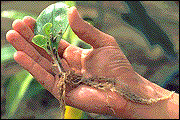
This rooted leaf and petiole of a peperomia has a new plant developing from the petiole.
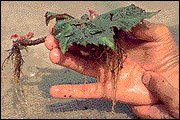
Begonia leaves can produce new plants not only from the petiole, but also from cuts made in the leaf veins.
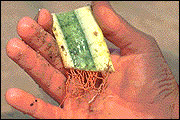
Some tropical plants such as sansevieria can be propagated using leaf pieces. This piece has roots developing at the base.

With stem cuttings, plants such as the dracaena shown can produce both roots and new shoots.
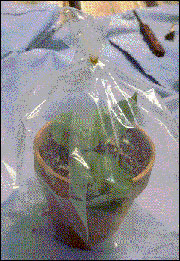
Propagating many tropical houseplants is easily done with good potting soil and a plastic bag.
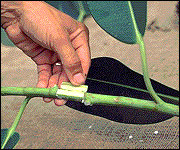
In preparation for air layering, a one-inch strip of bark on this rubber plant is being removed from around the stem. This makes it unable to move sugars down the stem, but water and nutrients can still move upward.

After applying a root-stimulating hormore, Sphagnum moss will keep the damaged area moist and protect new roots as they form.
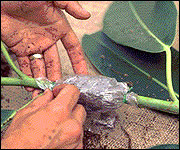
Properly wrapping the damaged area will retain the necessary moisture.

For this completed air layering procedure, some leaves were removed to provide enough room for the operation.
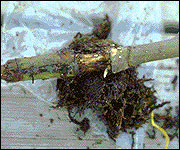
The sphagnum moss has been removed to show the beginning of root formation at the top of the wrapped area. After you see roots, you may remove the cutting from the parent plant and pot it.
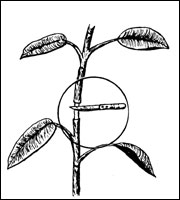 Remove strip of bark around the branch.
Remove strip of bark around the branch.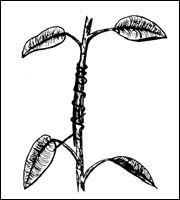 If stem is weakened by the cut, use a stick splint for support.
If stem is weakened by the cut, use a stick splint for support.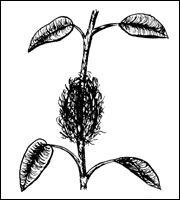 Cover with a ball of moist sphagnum.
Cover with a ball of moist sphagnum.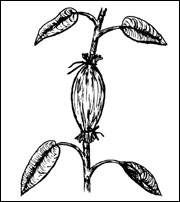 Wrap a piece of clear plastic around the branch and tie at each end.
Wrap a piece of clear plastic around the branch and tie at each end.